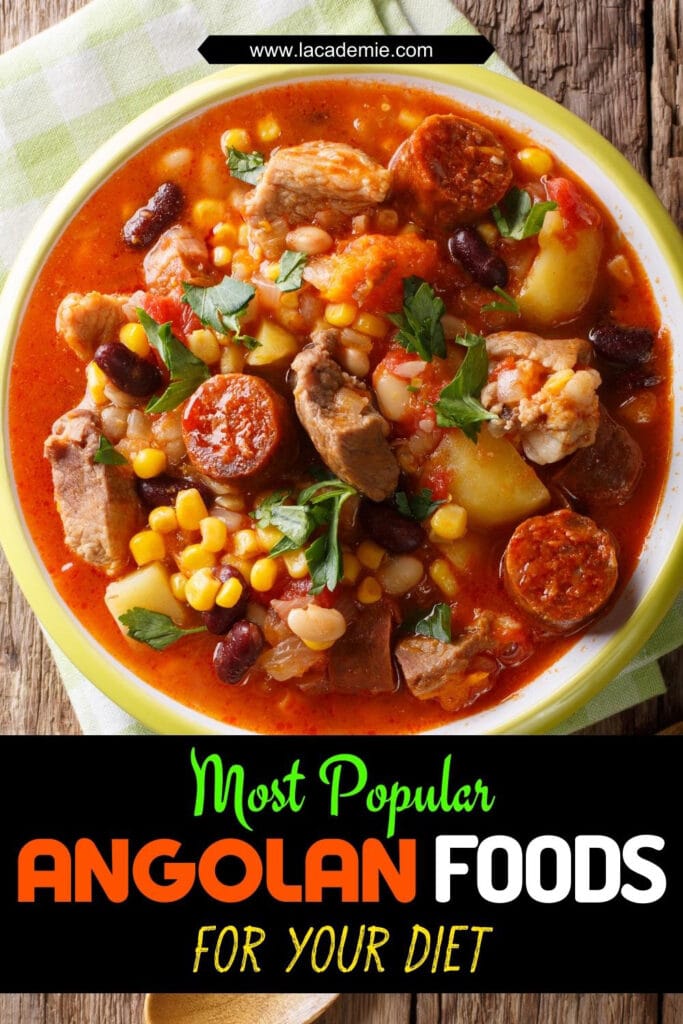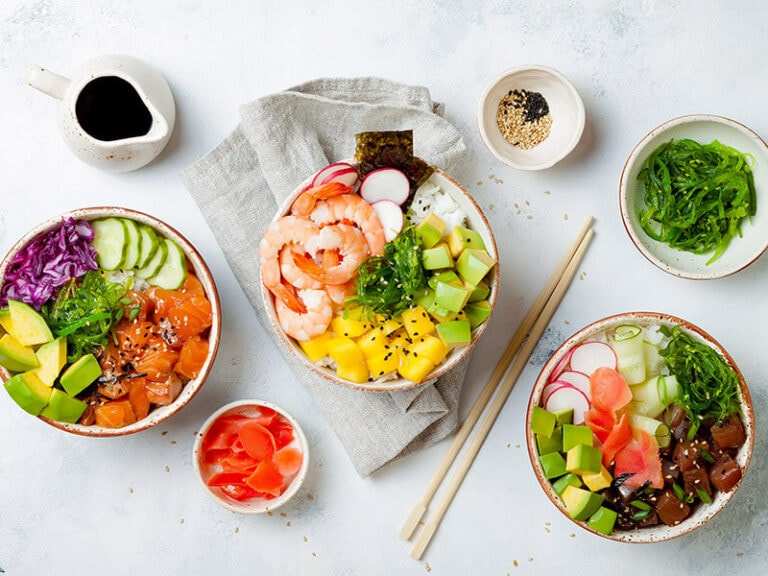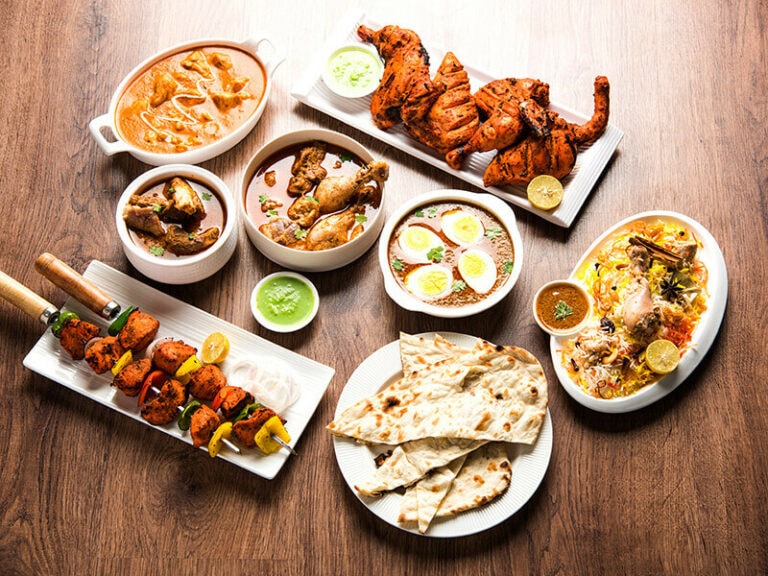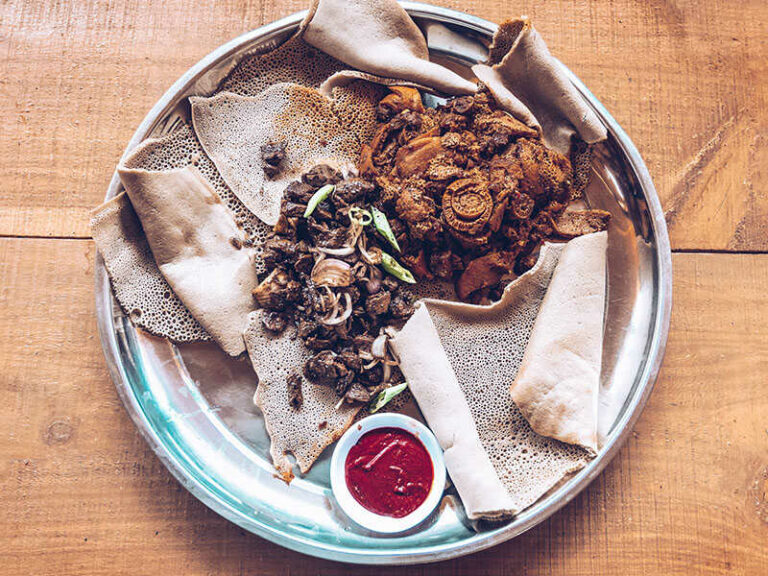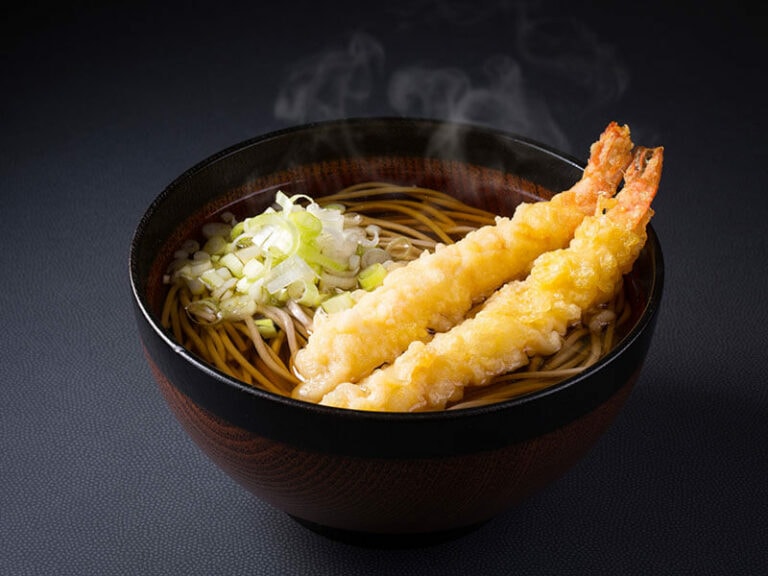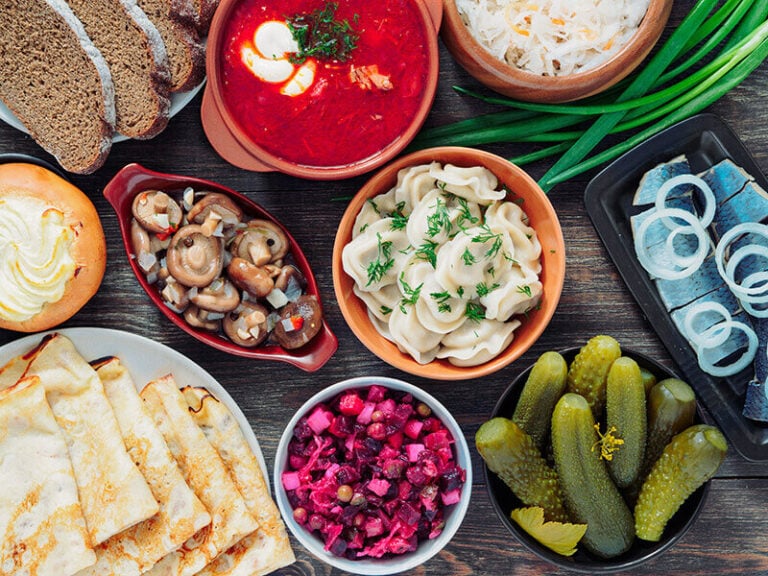Welcome to an in-depth journey through the diverse and delightful cuisine of Angola, a nation on the southwest coast of Africa. From sizzling meat dishes to hearty vegetarian meals and sweet treats that are hard to resist, this article will introduce you to twenty-one tantalizing Angolan delicacies.
In the first part, I will delve into Angolan non-vegetarian foods.
Next, we will explore the world of Angolan vegetarian foods.
Finally, we will conclude with Angolan desserts and snacks.
Ready to embark on this culinary adventure? Let’s start exploring the vibrant, rich flavors of Angolan cuisine.
- Calulu
- Cachupa
- Makayabu
- Caldo De Peixe
- Cabidela
- Muamba de Galinha
- Cabrito
- Bagre Fumado
- Mufete
- Kissuto Rombo
- Funge
- Farofa
- Kizaca
- Chikuanga
- Fumbua
- Arroz com Feijão
- Piri Piri Sauce
- Leite Azedo
- Ginguba Torrada
- Catatos
- Cocada Amarela
- Banana Assada
Angolan Non-Vegetarian Foods
If you love dishes made from meat or seafood to supplement a source of protein for your body, the foods in this section will be a suitable choice for your wish.
1. Calulu
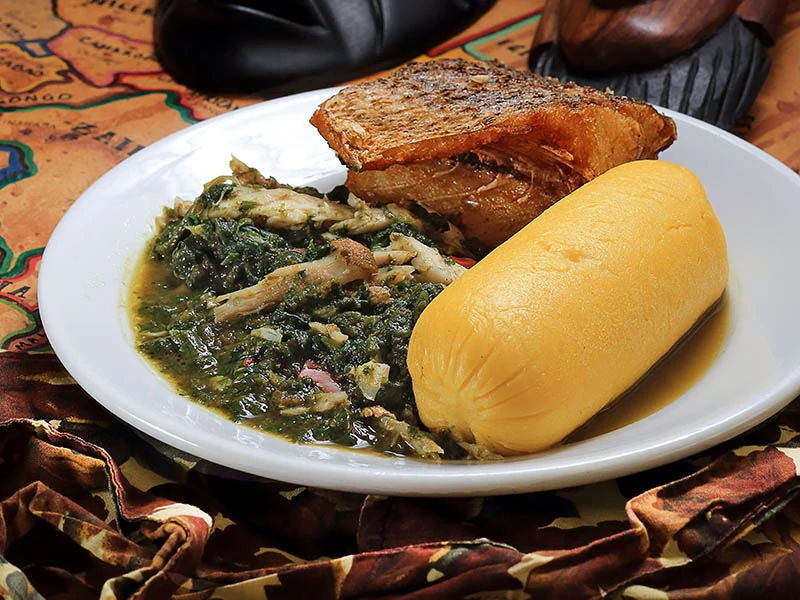
If you need to add an Angolan dinner recipe to the menu, you should consider Calulu. Angolans love it and cook it for their daily meals. It is a harmonious combination of vegetables and fish or meat that is good to eat with rice or cassava porridge (Funje).
The typical taste of Okra will fascinate you. Feel the flavor of potato leaves, onions, palm oil, and tomato in this stew. Angola is not the first place to make this food. It is a product of Brazilian cuisine, and it had the name “Caruru” originally.
2. Cachupa
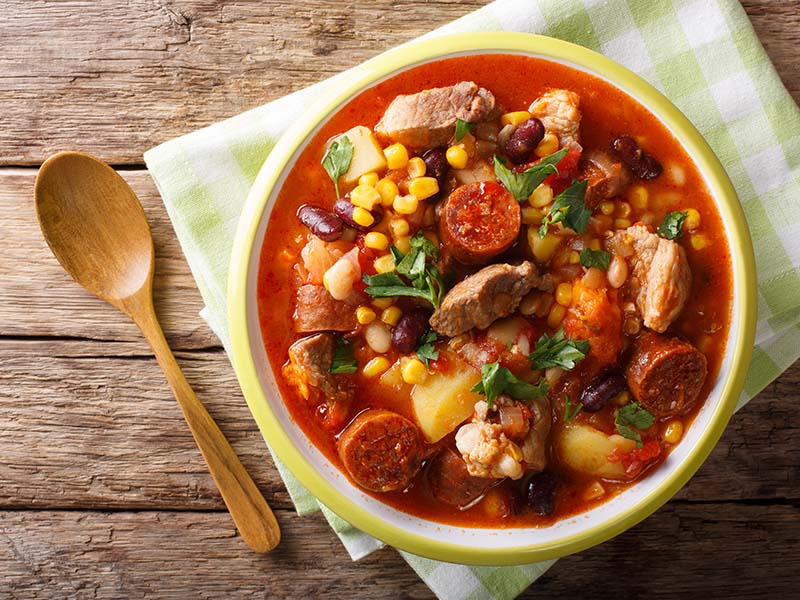
Cachupa used to be food for poor people with low prices and high nutritional value. This food is derived from Cape Verde (an island in the West African coastal region) from the 15th century when Portuguese colonists grew American veggies.
When it was introduced to Angola, it was modified to suit the local taste by Angolans. Besides beans as the main ingredient, you will find meat, potatoes, bacon, sausage, cassava, and cabbage in this food.
It has many different versions. Typically, you will find more ingredients in the Cachupa Rica version, while the Cachupa Pobre version will have fewer ingredients. Angolans also re-fry leftover Cachupa to serve with eggs or other dishes for breakfast.
3. Makayabu
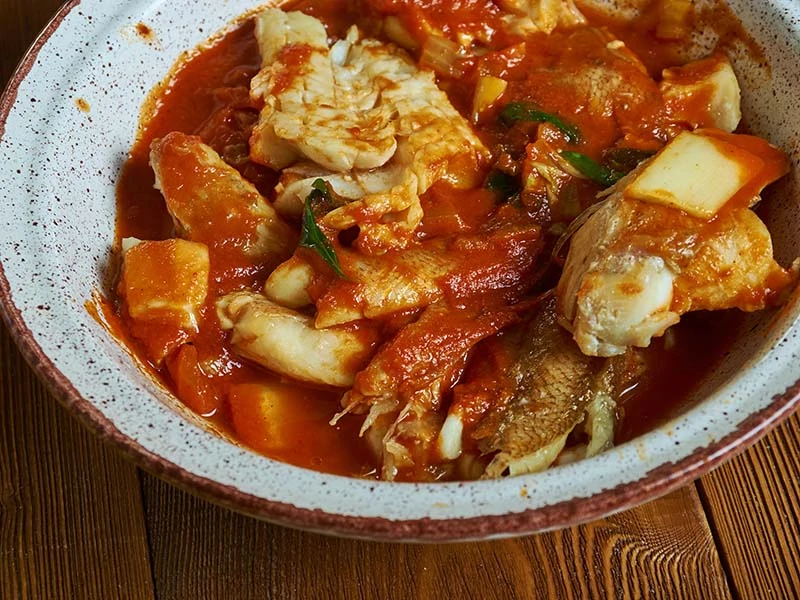
If you like dry fish, it is an excellent experience if you have a chance to try Makayabu in Angola. Although it is famous in Angola, Makayabu is authentic Congolese food. Cacusso or codfish plays a vital role in making this fantastic recipe.
After soaking about 2 hours in the water, the chef will marinate fish with spices, salt, tomato, vinegar, and cooking oil before cooking. Angolans usually eat it with Funge, Kizaca, Calulu, and cabbage to enhance the taste.
4. Caldo De Peixe
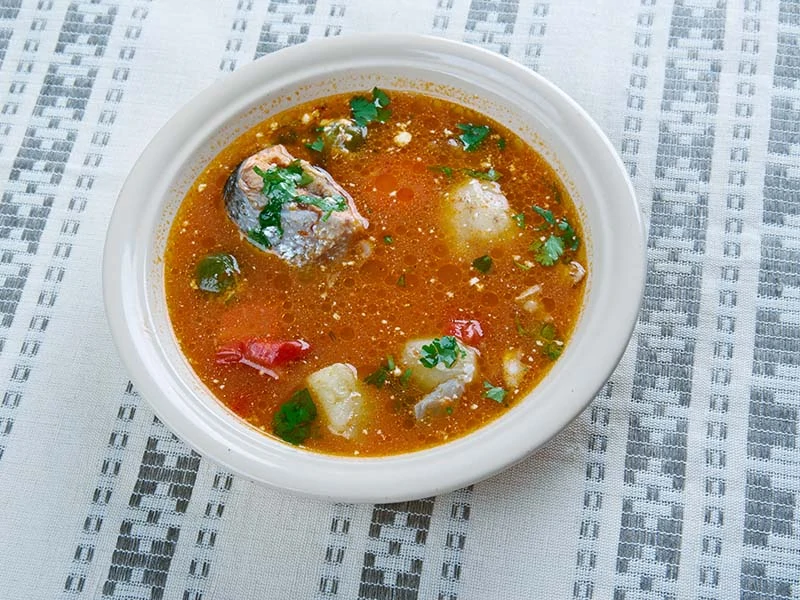
Although it does not have originated in Angola, it is a favorite Angolan breakfast recipe of the people here. This excellent food originated from Minho province in the north of Portugal. Gradually, it was introduced in Angola, Brazil, and other countries.
You will immerse yourself in the natural flavor of fresh fish when enjoying it. Angolans often eat it with sweet potatoes and cassava on breakfast after the parties to cure hangovers. The plentiful amount of nutrients in the fish will help cleanse up your system faster.
5. Cabidela
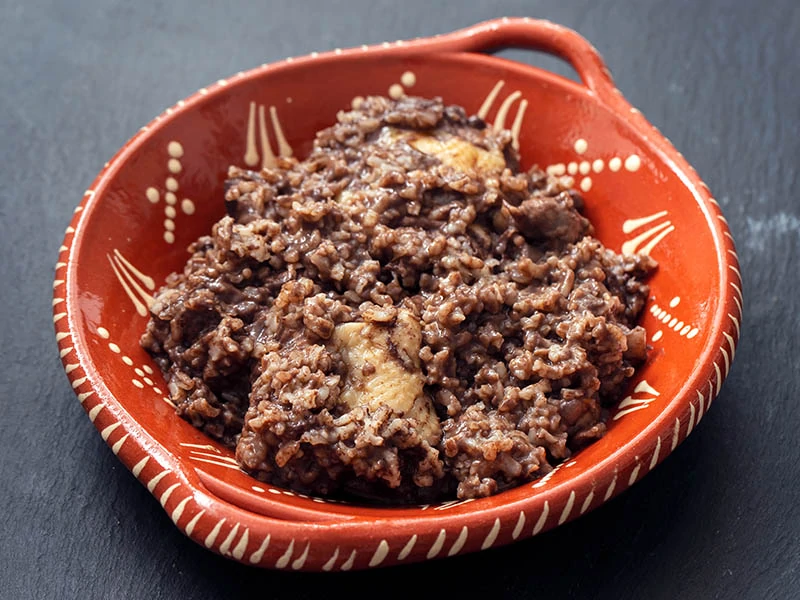
Cabidela originated from Portugal and is especially popular in the northern region of Minho. This Portuguese food has been around in Angola for so long that it is virtually a staple dish in this African country. Cabidela is a combination of rice and chicken, usually a hen.
In particular, chicken blood will be added to this food along with vinegar. The hen is sometimes replaced by duck, turkey, or pork in Angola. You will love the tenderness of the chicken and boiled white rice. Besides, Angolans also eat it with Funge.
6. Muamba de Galinha
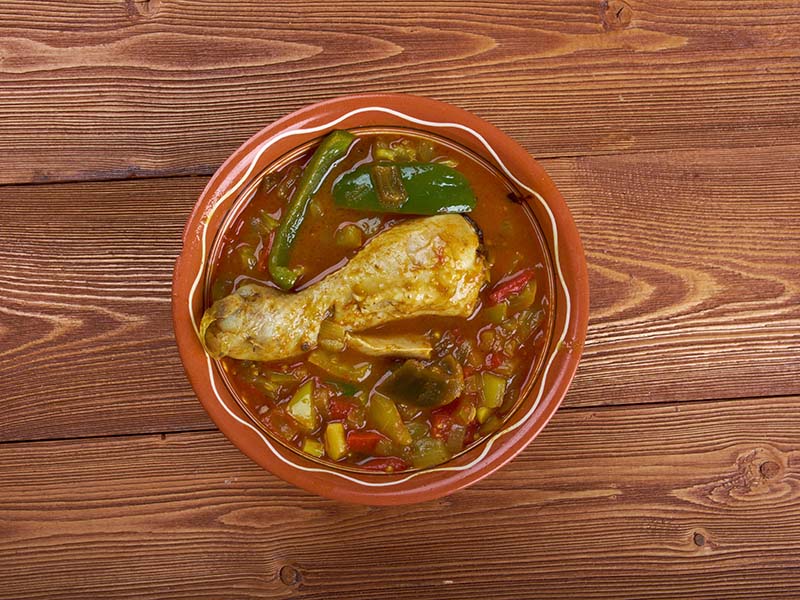
Muamba de Galinha is a great recipe to fill your hungry stomach. This food appeared on the CNN list of the world’s 50 best foods in 2011. The dish originated in Central Africa and is a national food of Angola.
You will be addicted to the flavor of this chicken stew. Chefs will slowly cook chicken with squash, okra, and muamba de dendem (red palm oil sauce) to make this delicious and attractive food.
The restaurant often serves it with Funge (cassava flour cooked in boiling water). Occasionally, chefs will add Gindungo, a kind of Angolan hot chile pepper, to this food to create a spicy kick.
7. Cabrito
If you are a fan of goat meat, you should not miss Cabrito. Goat meat is a common ingredient in many foods of Angola. You can easily find goat meat products of Angola exported to many countries worldwide.
You will immerse yourself in the tenderness and fantastic flavor of goat meat cooked with onions, herbs, and salt. Angolans usually eat it with rice, Calulu, Jimboa, and Kizaca during celebrations, parties, and other special occasions.
8. Bagre Fumado
If you travel to the north region of Angola, you will have an opportunity to enjoy the incredible flavor of Bagre Fumado. It is a type of dried catfish. The fish will become more flavorful when cooked with onions, tomato, and salt.
This dish is a typical food of people along the rivers in Angola. To increase the flavor of this recipe, Angolans will eat it with sweet potatoes, okra, and Funge. It is time to fall in love with its enchanting flavor right now.
9. Mufete
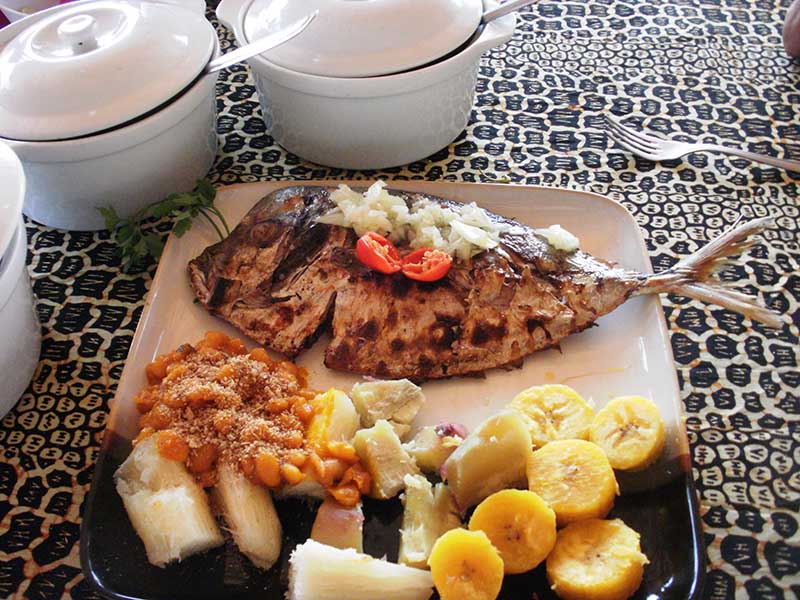
When it comes to Angolan cuisine, you have to mention Mufete, which is one of the most famous foods in this African country. It originated from the Luanda region. Initially, it appeared at weddings and celebrations, but locals enjoy this dish for daily meals nowadays.
The beaches in Luanda have a lot of cacusso fish, and it is the primary ingredient that usually appears in the Mufete. Besides grilled fish, the food contains beans, red oil, boiled plantain, sweet potatoes, and flour.
10. Kissuto Rombo
Kissuto Rombo is a traditional recipe of Angolan cuisine. This food includes goat meat, lemon juice, garlic, hot peppers, white wine, and other spices. To make this dish, chefs marinate meat with spices overnight to cook it the next day.
When roasting the meat in the oven, the chef will baste it with white wine regularly to enhance its flavor. This delicious food is a perfect option to combine with rice and chips. Impressively, the meat still retains tenderness and juiciness after roasting.
Angolan Vegetarian Foods
Nowadays, many people follow a healthy diet with vegetarian foods. If you are one of them, there is no reason to refuse the fantastic foods in this section.
11. Funge
Funge (or Funje) is a favorite Angolan lunch recipe that many visitors look forward to enjoying when arriving at Angola. This famous dish is processed from Fuba (corn flour) or Yuca (cassava). People in South Angola often eat Funge containing corn, while Funge with cassava is more prevalent in the North.
Angolans often eat it with meat, fish, and vegetables. To enjoy the richer taste, you can try the versions containing stock, such as meat or fish stock. In particular, you will use your fingers to eat this food.
You will crush the Funge into a small ball and dip it into sauce or stew to enjoy. This traditional food is similar to Pirao of Brazilian cuisine and Cou-Cou of Lesser Antilles.
12. Farofa
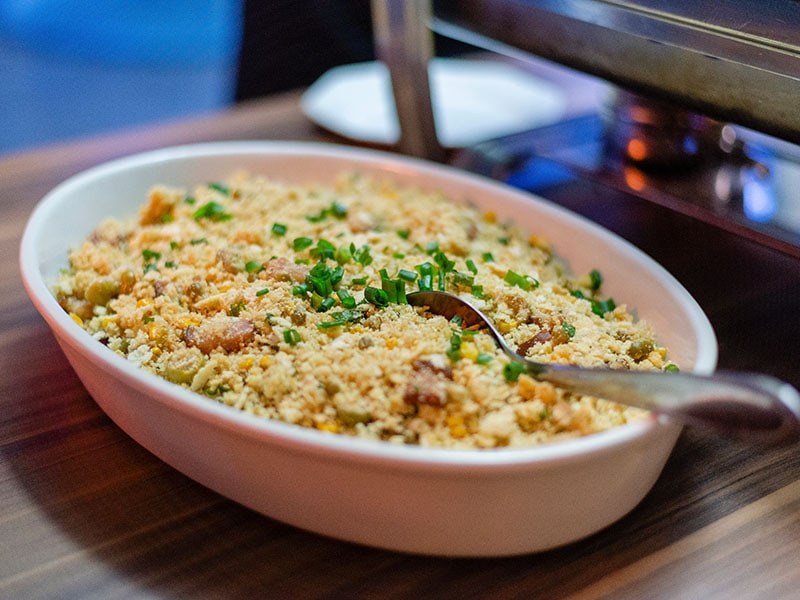
Farofa is a nutritious recipe created by Tupi-Guarani Indians in Brazil. Later, Portuguese colonists invaded the land, learned how to make the dish, and spread it to other colonies under their control, including Angola.
Despite originating in Brazil, this cassava flour-based food is prepared commonly across Angola. This nutritious food usually appears with meat, beans, and rice dishes. The chefs also toast it with sausage, pork, and eggs until the Farofa is golden brown.
13. Kizaca
You will not be able to resist the attraction of Kizaca when enjoying it. This famous food is the combination of European and South African cuisine because Angola has been the colony of Portuguese colonials for a long time.
Cassava, which is the main ingredient of this food, was brought from Brazil to Angola by the Portuguese. Locals will cook cassava leaves and peanuts until a thick texture is obtained. They also make the dish more flavorful with tomatoes, salt, vinegar, and onions.
Angolans often combine it with meat or fish in meals. It has a variation named Kizaka Com Peixe containing fish and tomatoes. In addition, Angolans often use spinach to replace cassava leaves.
14. Chikuanga
Chikuanga is a well-known bread processed from cassava. This fantastic food is a specialty of people in the northeast of Angola. The softness and flexibility of cassava flour will leave deep impressions in your mind.
The flavor of banana leaves is a characteristic feature of this food. Cassava will be more fragrant and delicious when wrapped in banana leaves before boiling. It is fantastic to enjoy Chikuanga with Bagre Fumado and Mufete.
Most Angolan restaurants often serve warm Chikuanga with stews, sauces, and soups to help reduce the spiciness of those foods. This recipe usually appears in the form of thick round slices on the plate.
15. Fumbua
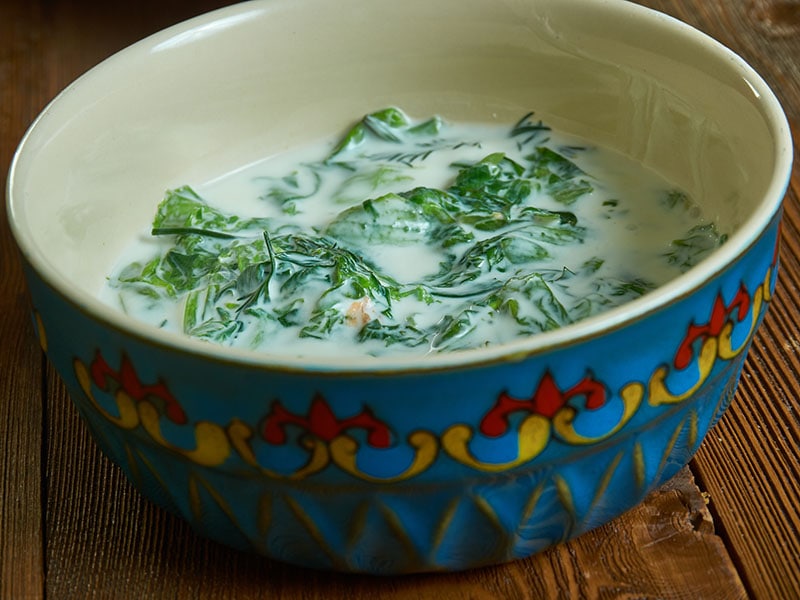
Fumbua is a food made from leaves found in tropical forests in Africa. These leaves only grow naturally, and people cannot cultivate them. This stew contains tomatoes, onions, palm oil, and ground peanuts.
It is a specialty in the North of Angola and is favored by the people here. Besides, Congo is also the nation where this food is popular. Fumbua contains many vitamins and is often eaten with Funge, Bagre Fumado, and Chickuanga.
Treat your loved ones by cooking outstanding Fumbua.
16. Arroz com Feijão
Arroz com Feijao is suitable for recharging energy after a long day in Angola. It is a recipe of Brazilian cuisine and is popular in many South American countries. It is a nutritious food with a lot of protein, iron, vitamin, calcium, and carbohydrates.
Arroz com Feijao is a staple food in Angola as you can catch it on the dining table of Angolans anywhere. To increase the flavor and tickle taste buds, Angolans will eat it with Kizaca, Jimboa, and Calulu.
17. Piri Piri Sauce
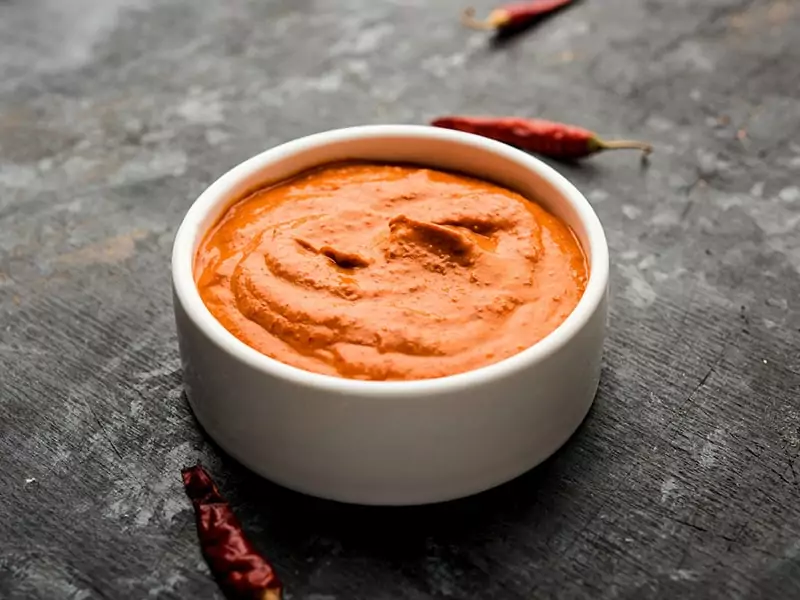
Piri Piri is a famous spicy sauce in many African countries. This fantastic recipe was created by Portuguese explorers around the 15th century when they found bird’s eye chili pepper in Portugal’s then-territories in Southern Africa, especially Mozambique.
This type of chili is the main ingredient of this sauce. In addition, the appearance of garlic, vinegar, red wine, paprika, and other European materials helps the taste of Piri Piri become more diverse. Nowadays, you can easily find the sauce in Australia, North America, and Europe.
Angolan Desserts And Snacks
After enjoying these heavy dishes in the above sections, it is time to refresh your mouth with amazing Angolan desserts and snacks. Let’s diversify the foods on your dining table now.
18. Leite Azedo
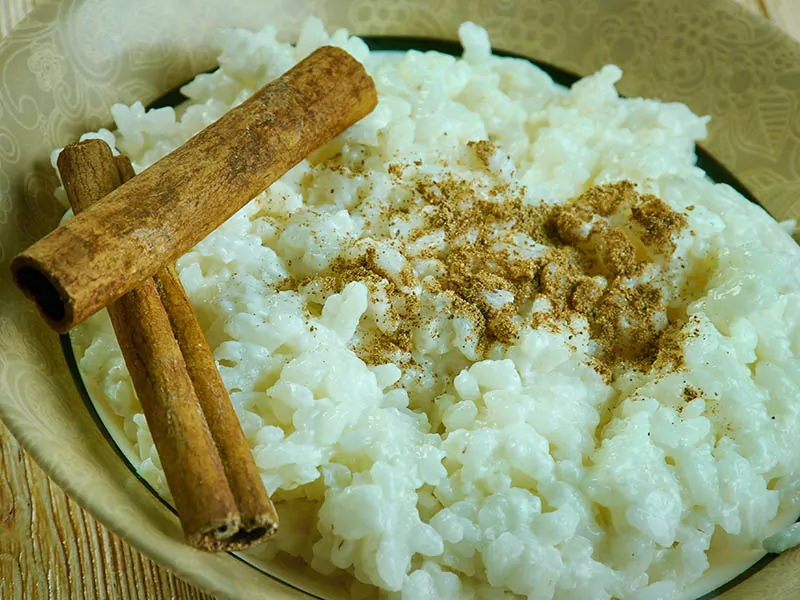
Leite Azedo is an Angolan dessert recipe loved by many tourists when they step into this country. This dessert is an initiative of a Mucubal ethnic minority group in Namibe in South Angola. It is made from a milk preservation method.
Mucubal women will use a hollowed-out gourd to accommodate cow’s milk. Dairy products after fermentation are called Leite Azedo. Angolans often eat it as a dessert or combine it with Funge. The gentle sourness creates the distinctive feature of this food.
In particular, you will not be able to find this yummy African dessert in the markets because Angolans only prepare it for personal use. It is an essential component in traditional specialties like Maine and Manhini.
19. Ginguba Torrada
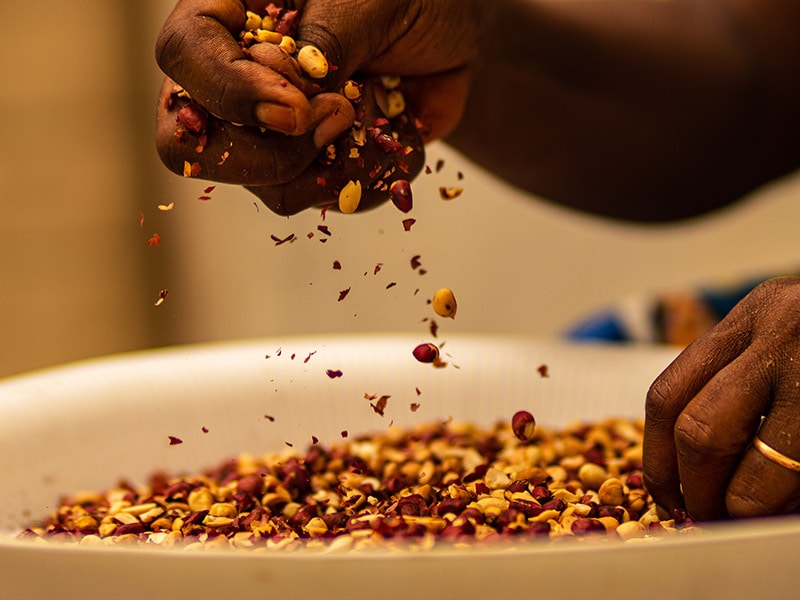
Ginguba Torrada is a great food to enjoy when you walk on the streets in Angola. Peanuts are the primary ingredient of this snack. You will especially adore the charming aroma and incredible taste of toasted peanuts while eating Ginguba Torrada.
In the local language, the word “Gunguba” means “peanuts”. Angolans often mix it with roasted plantains or grilled cassava. You can also find it accompanied with Mukua and Kissangua on the dining tables in Angola.
20. Catatos
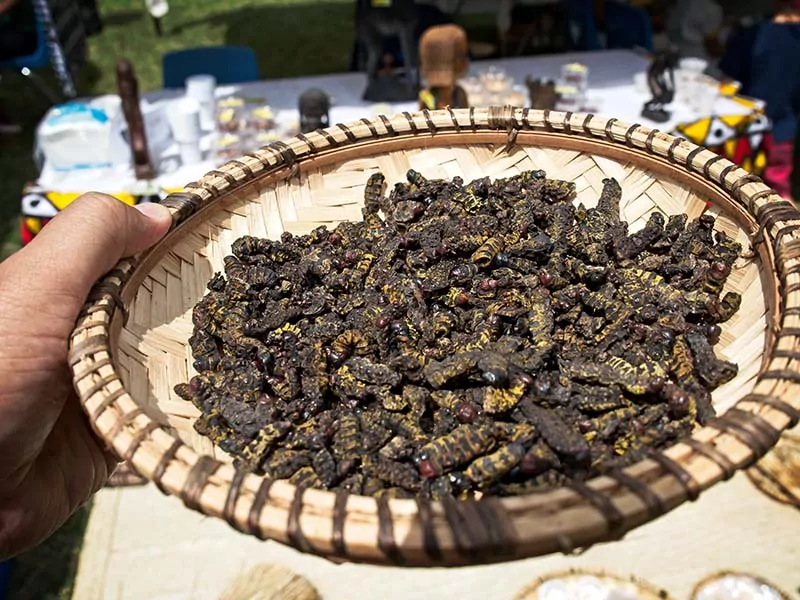
Catalos is a strange and unique recipe of Angolan cuisine. This food will stimulate your taste buds and curiosity. The main element of this well-known food is caterpillars. After they are fried with garlic, you will have a delicious and nutritious snack.
Its flavor becomes more appealing with peppers, tomatoes, and onions. Fried caterpillar’s softness and crispiness will give you a wonderful mouth feel. Catatos will often be served with rice, hot sauce, and Funge. It contains many good nutrients for the body, like protein and iron.
There are many ways to collect caterpillars. Children often catch them from the trees, and adults will find them in fields. It is a famous food in Uige province in northwest Angola.
21. Cocada Amarela
When referring to Angolan desserts, it is impossible not to mention Cocada Amarela. This is a traditional dessert containing eggs and coconut. The abundance of eggs used in this food leads to a beautiful golden shade.
Its name “Cocada Amarela” means “yellow Cocada”. Because of the profound influences of Portuguese cuisine on Angolan cuisine, this food is pretty similar to Portuguese pastries, especially in the liberal use of egg yolks.
22. Banana Assada
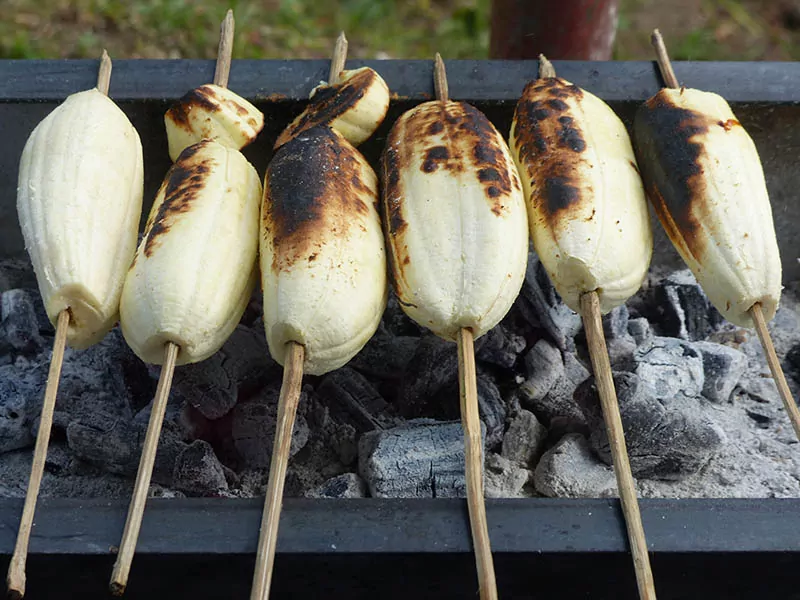
Bananas and plantains are popular foods in Angola. They appear in many different dishes, from main dishes to side dishes to tasty desserts. Angolans often use them to replace rice and potatoes during meals.
Banana Assada is one of the appealing foods made from bananas. The natural sweetness will make you love it on the first try. The typical smoky taste of grilled banana will make it unforgettable. In addition, the characteristic sweetness of honey will enhance its quality.
Conclusion
In this culinary exploration of Angola, I have encountered a variety of dishes that reflect the rich culture and diverse tastes of this African nation:
- Angolan Protein Dishes: From the fish-based Calulu to the chicken delight of Muamba de Galinha, we’ve discovered ten dishes that showcase the flavorful meats and seafood of Angola. Each dish is a unique blend of ingredients and techniques, offering an exciting taste of the local cuisine.
- Angolan Vegetarian Dishes: Whether it’s the cassava-based Funge or the fiery Piri Piri sauce, the vegetarian dishes we have explored bring out the bounty of Angola’s land. These seven dishes prove that vegetarian food can be just as hearty and flavor-packed as their meaty counterparts.
- Angolan Desserts and Snacks: Our exploration concluded with four sweet delights, from the creamy Leite Azedo to the coconut-infused Cocada Amarela. These desserts and snacks showcase the sweeter side of Angolan cuisine, offering a perfect end to a delicious meal.
In conclusion, Angolan cuisine offers a vast array of flavors and dishes, catering to every palate. It stands as a testament to the country’s rich cultural heritage and the creativity of its people. Whether you’re a seasoned food enthusiast or a novice explorer, Angolan cuisine promises a mouth-watering culinary adventure.
